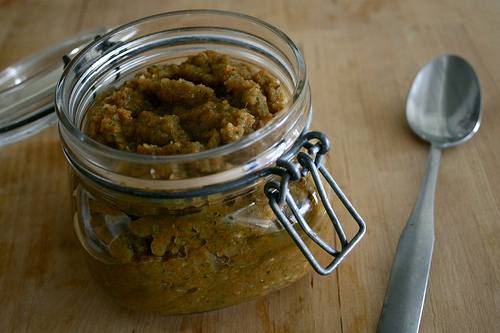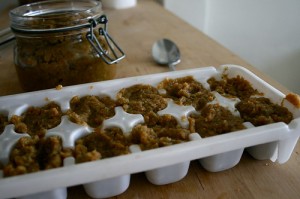
photo provided courtesy of affairsofliving.com
I generally make my own vegetable broth from vegetable scraps and trimmings, but recently purchased a quart of store-bought broth in a pinch. Blech! I forgot how weird-tasting store bought vegetable broth is by comparison, especially for the price of an organic broth without creepy stuff in it. I swore I’d never do it again, even in a pinch, and vowed to only make my own vegetable broth from now on. So, I started collecting all my little vegetable scraps again for my next pot of broth.
The next day I was catching up some reading over at 101 Cookbooks, one of my favorite blogs, and came across Heidi’s post for homemade vegetable boullion. I flipped out! Why hadn’t I ever thought of this?! It seemed so simple. Bouillon is just ground of vegetables and spices, so why can’t we make our own, right? Geez.
I knew I had to try it immediately.
Making bouillon from scratch is the perfect allergy-friendly, gluten-free solution to the problem of broth. Broths and bouillons often contain yeast extracts, preservatives, or tons of vegetables and spices that may be problematic if you have a lot of allergies and sensitivities. Since you’re choosing the ingredients, you can choose to add or subtract whatever works or doesn’t work for you. This recipe is so wildly versatile, I can’t wait to try it again with different vegetables or seasonings.
This recipe makes a hefty batch – about 3 1/2ish cups – which is more than you will probably need for a week of cooking, unless you have a big family or are making lots and lots of soup. The solution? Freeze a portion of the batch in ice cube trays, then transfer the cubes to a freezer bag for later use. Just toss a few frozen cubes in to your soup kettle or rice pot, and you’ll have tasty broth in no time!
I’ve been using the bouillon all week in soups, threw a scoop into the pot when cooking rice, and also mixed it with vegetables before roasting them. I have positively loved it! So flavorful, so fresh, and so easy. And much cheaper and more nutritious than buying that stuff at the store. If you are on a strict rotation diet, you could modify this recipe to have only a few ingredients, so it fits with your rotation. Here is the recipe for my version of the bouillon:
 ingredients
ingredients
inspired by Homemade Bouillon Recipe from 101 Cookbooks
You will need a food processor or Vitamix to make this. I chose to make it in my food processor, and added the vegetables in batches, grinding between adding to make more room in the processor. Store in the fridge in a well-sealed container for 5 days, or freeze in small portions to use later on! I love ice cube trays for this very thing. I did not make this very salty, so that it is more versatile and I can salt the dish I use it in to my preference later on. I added miso paste for a rich flavor; feel free to omit if desired. The beneficial bacteria of the miso will be cooked out once the broth is heated, but the delicious flavor will remain!
3 large carrots
3 celery stalks
1 large leek
1 very small onion (or probably about 1/4-1/2 of a medium onion)
4 garlic cloves
1/2 large fennel bulb, with stalk and fronds
1/4 cup packed parsley leaves
1 tsp dry thyme
1 tsp salt
optional: 3 Tbsp azuki or chickpea miso
directions
- Chop all ingredients and place in a food processor.
- Pulse a few times, then process until you have a smooth vegetable paste.
- Place a small amount in a container in the fridge and use within 4 days. Freeze remaining boullion in ice cube trays, then package in freezer bags. Easy broth!
- To use: use 1 Tbsp bouillon per 8 oz of water
makes approx 3 1/2 cups
recipe courtesy affairsofliving.com










Hey there!
Any tips on how to make stock from vegetable scraps? I’ve tried twice and both times failed. Mostly I used carrot peels, carrot tops and the ends/leaves of celery and a few miscellaneous vegetable scraps. How do I get it to taste good without spending extra cash (ideally two quarts worth for around $2 or less)? The idea of using my vegetable scraps is very appealing to my pocketbook but I just can’t figure it out.